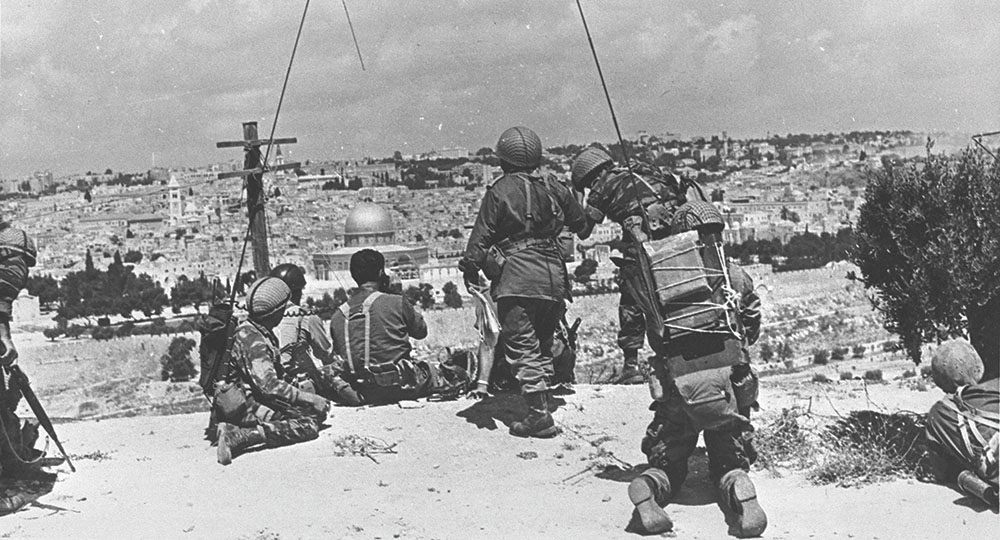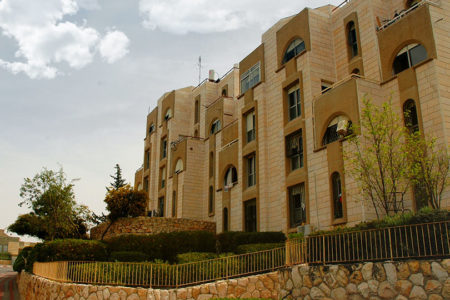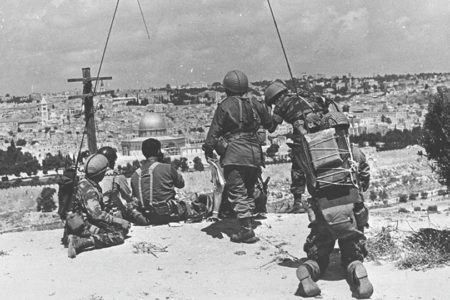Six Days In June
June 7 marks the 50th anniversary of the reunification of Jerusalem Here is a look at the 1967 Arab-Israeli war that saved the Jewish state from destruction and made God’s eternal city whole again.
For deeper insights into this article, listen to our radio host, Chris Katulka interview Elliot Jager. (Interview begins @ 14:43)
When the 1967 Six-Day War erupted, the Jewish state had just celebrated 19 years of independence. Levi Eshkol, 71, was both prime minister and defense minister. Eshkol had replaced the legendary David Ben-Gurion in June 1963. Filling Ben-Gurion’s shoes had been anything but easy—particularly with the “Old Man” second-guessing him from the sidelines.
At 7,993 square miles, Israel 50 years ago was smaller than Vermont. Its population was 2.5 million (including 261,000 Arab citizens); immigration was slowing, as was the economy; and unemployment stood at 10 percent. Many big companies were state-owned, and Eshkol had to sell some of these assets to balance the budget.
But life wasn’t all bleak. Television had arrived in 1966, so middle-class Israelis now enjoyed both a local educational station and English-language broadcasts from neighboring Jordan. A general-interest Israeli channel was also in the works.
Having fought its way to independence in 1948—and losing 1 percent of its population in the process—the Israel of 1967 had no permanent borders. For boundaries it had only the 1949 armistice lines. The country was surrounded by 14 hostile Arab nations whose combined population stood at 110 million.
In America, President Lyndon B. Johnson was in the White House, the war in Vietnam was raging, and race riots roiled U.S. cities. The number-one bestselling book was William Manchester’s The Death of a President about the 1963 assassination of President John F. Kennedy. Under Kennedy, the United States had authorized the first direct arms sale to Israel of Hawk surface-to-air missiles. France was Israel’s main arms supplier.
The Backstory
The 1950s had seen dozens of fedayeen (Arabic for “men of sacrifice”) attacks on Israeli soldiers and civilians across the armistice lines. Then, in 1956, Egyptian President Gamal Abdel Nasser nationalized the Suez Canal that connects the Mediterranean and Red Seas, angering France and Britain, both of which were invested strategically and financially in the canal.
Egypt had also been encouraging attacks on Israel from Egyptian-held Gaza. Thus, in an alliance of convenience with Britain and France, Israel attacked and captured the Sinai Peninsula and Gaza Strip.
Intense pressure from the Dwight Eisenhower administration, however, compelled Israel in 1957 to withdraw to the 1949 armistice lines without any guarantees that its shipping would be unimpeded or that attacks from Egyptian-controlled territory would stop. Terror attacks, sniping, and shelling from Egyptian Gaza, Jordan’s west bank, and Syria continued to take their toll on Israeli lives and nerves.
Meanwhile, also in the 1950s, a nucleus of Arab university students living in the Persian Gulf states established the Fatah, or conquest movement. Among the students was Yasser Arafat, who later became an arch terrorist and key Palestinian-Arab leader.
In 1964 the Arab League created the Palestine Liberation Organization (PLO) under Ahmad Shukeiri, who was part Palestinian-Arab and part Turkish. In 1965 the PLO was officially launched in Jordanian-controlled eastern Jerusalem, and its charter calling for Israel’s destruction was adopted. In 1969, Fatah took control of the PLO.
In Israel’s north, settlements in the Hula Valley had come under periodic Syrian fire. From the northern shores of the Sea of Galilee, Syrian snipers shot at Israeli fishermen and farmers. Saboteurs planted land mines, and the Israel Defense Forces (IDF) took casualties trying to block infiltrations. The Arab states also colluded to divert water originating in Lebanon and Syria from reaching Israel.
Then as now, Syria’s internal situation was unstable. A fractious Ba’ath Party had ruled the country since 1963, and behind the scenes two strongmen controlled power: Salah Jadid and Hafez al-Assad, father of current Syrian President Bashar al-Assad. Fronting for them was Syrian Prime Minister Yusuf Zu’ayyin, who declared, “We shall set the area afire, and any Israeli movement will result in a final grave for Israel.”
There were also Fatah attacks from the Jordanian-held West Bank. Terrorists tried to blow up a Jerusalem residential building a few miles from the armistice line that divided the city into Israeli- and Jordanian-ruled sectors. In January 1965, Fatah tried to sabotage Israel’s water supply. That October, a cargo train running on the single track connecting Tel Aviv to Jerusalem hit a land mine and derailed.
On a Friday evening in November 1966, three army reservists were killed when their jeep hit a Fatah-planted land mine near Arad. The news reached most Israelis only after Shabbat, and there were calls for harsh retaliation. Using U.S. channels, Jordan’s King Hussein wrote Eshkol to express Jordan’s condolences. However, by the time the message reached Eshkol, a massive retaliatory operation was already under way. Many houses in the village of Sam’ua where the gunmen had originated were destroyed.
The objective had been to pressure Jordan to crack down on Palestinian-Arab gunmen operating from the West Bank. But critics thought the result was counterproductive since it made Hussein look weak. Doing nothing, however, was not an option for Eshkol.
Between April and May 1967, Fatah launched more than a dozen attacks along the Syrian, Jordanian, and Lebanese borders. On April 7, 1967, after the Syrians heavily shelled northern Israeli settlements, the Israel Air Force (IAF) retaliated against targets in Syria. Confronted by MiG fighters over the Syrian-controlled Golan Heights, the IAF shot down seven Syrian warplanes. In May, Damascus turned to Cairo for backing.
By spring 1967, tensions were reaching an explosive point. Yet, as Michael Oren writes in Six Days of War, the conflagration can’t be traced to any single incident or individual but, rather, to “an atmosphere of extreme flammability.”
The interlude from May 14 until the war broke out on June 5 was one of high tension and came to be known in Hebrew as HaHamtana, or “waiting period.”
‘It All Began When You Hit Me Back’
Arab leaders were incensed over Israeli reprisals. Egypt demanded—and UN Secretary-General U Thant readily consented—to pull from Sinai the international peacekeepers who had been stationed there as part of the ceasefire deal that ended the 1956 Sinai Campaign.
The casus belli (war’s justification) came on May 17, 1967, when Nasser began to remilitarize the Sinai Peninsula, moving in some 100,000 soldiers and more than 1,000 tanks. Then, in the early morning hours of May 23, Egypt closed the narrow Straits of Tiran, effectively blockading the Israeli city of Eilat and the Gulf of Aqaba to Israeli shipping.
President Lyndon Johnson took a cautious approach, saying “the purported closing” of “what the United States considers…to be an international waterway” had exacerbated the existing crisis. On May 31, Britain’s Prime Minister Harold Wilson told Parliament, “Israel has a right to live”; but Foreign Secretary George Brown said London opposed aggression by either side. Privately, Wilson was said to be prepared to sell Israel tank ammunition, but he told Israeli Foreign Minister Abba Eban he didn’t want to be seen publicly siding with Israel.
War fever now gripped the Arab world—and Israel prepared for the worst.
“Our basic objective will be the destruction of Israel,” Nasser declared on May 27. “The Arab people want to fight,” he said. Mining the Straits of Tiran was intended to ignite a confrontation with Israel. “Adopting this measure obligates us to be ready to embark on a general war with Israel,” Nasser said.
Faced with the prospect of war with Egypt in the south and Syria in the north, Israel entreated Jordan on the east to remain neutral. Nonetheless, on May 30, King Hussein flew to Cairo to sign a mutual defense treaty with Nasser that put Jordan’s forces under Egyptian command. Iraq and other Arab countries made similar arrangements with Cairo.
On May 30, Cairo Radio revved up its intimidation: “With the closing of the Gulf of Aqaba, Israel is faced with two alternatives, either of which will destroy it; it will either be strangled to death by the Arab military and economic boycott, or it will perish by the fire of the Arab forces encompassing it from the south, from the north, and from the east.”
PLO leader Shukeiri declared on June 1, “This is a fight for the homeland—it is either us or the Israelis. There is no middle road. The Jews of Palestine will have to leave. We will facilitate their departure to their former homes. Any of the old Palestine Jewish population who survive may stay, but it is my impression that none of them will survive.”
Israel Braces for War
To many it looked like the beginning of the end. That the Arabs were planning a massive offensive was obvious. By conservative estimates, Israel confronted an initial combined Arab force of 200,000 troops, 1,600 tanks, and 700 warplanes. MiG fighters had managed to fly—albeit 10 miles high—over Israel’s Dimona nuclear reactor. Nasser’s use of poison gas in Yemen four years earlier further frazzled IDF intelligence.
Eshkol worried over Israel’s “very existence.” “We have to do our utmost to avoid bloodshed on either side,” he told the Israeli people. And so Jerusalem appealed to the international community, pointing out that closing the Straits of Tiran was a blatant act of war under international law.
Eban was dispatched to various European capitals to seek support but came back empty-handed. France’s President Charles de Gaulle advised Israel to do nothing. On May 31, Mossad chief Meir Amit left Israel for a clandestine meeting at the White House with U.S. Secretary of Defense Robert McNamara. During the meeting, Johnson called twice, asking to be apprised. On the way back to Israel, Amit’s cargo plane landed in Europe to load up with gas masks. He went directly to Eshkol’s place and offered a hazy assessment of U.S. policy: It seemed that Israel was not being unequivocally directed not to go to war.
Left up in the air, Eshkol created an emergency government that included opposition leader Menachem Begin and David Ben- Gurion’s political ally, retired Gen. Moshe Dayan, as minister of defense. Yitzhak Rabin was in place as IDF chief of staff.
Internal Israeli Bickering
Eshkol and Ben-Gurion had a testy relationship. Ben-Gurion, now 80, denigrated Eshkol as too willing to compromise. To mark its 19th Independence Day on May 15, Israel had conducted a modest military parade— so modest that Ben-Gurion stayed away in protest. Eshkol pointed out that he was only trying to abide by the 1949 armistice agreement.
No matter. Western powers like Britain saw any parade as “provocative” and already had rejected Israel’s claims to any part of Jerusalem. Ben-Gurion secretly summoned Rabin on May 21 and berated him—not for inaction but for his apparent public bellicosity and for mobilizing the reserves. Shattered by the criticism (some said he had a nervous breakdown), Rabin offered his resignation to Eshkol on May 25. The premier, taken aback, dismissed the resignation idea outright.
Around the world, Jewish volunteers flooded Israel’s embassies, offering their help. Many ultra-Orthodox Jews—whose rabbis opposed secular, political Zionism—nonetheless held urgent assemblies at which the Psalms were recited.
Israel Strikes First
On June 5, 1967, Eshkol ordered the Air Force (flying Frenchmade Mirage III fighter bombers) to attack Egyptian air bases. Long weeks of Cabinet deliberations, recriminations, and frayed nerves regarding whether striking first would boomerang against Israel diplomatically or strategically were over. The Cabinet decided Israel would not wait to be overwhelmed.
IAF planes flew low, avoiding radar, and destroyed almost all of Cairo’s Soviet-manufactured MiG-21s on the ground. Enemy runways were bombed; gaping craters made them unusable.
The ensuing war did not play out according to a tight script; there was continuous Cabinet debate about mission and strategy.
Within days, about 400 warplanes belonging to five Arab states were destroyed. Israel lost 19 planes primarily to ground-based antiaircraft fire. Avi Hoffmann, a former military correspondent for The Jerusalem Post, called the IAF’s performance the most stunning achievement of any air force in the history of warfare.
With Israel commanding the skies, the IDF attacked the Gaza Strip and then the Sinai. By the evening of June 7, Israeli forces had reached the Suez Canal. Hundreds of Egyptian tanks were destroyed, and thousands of Egyptian soldiers were captured.
Egypt’s naval blockade of the Straits of Tiran had been shattered. On June 8, Nasser accepted a ceasefire.
The news was equally encouraging on the Syrian front. Schools in Damascus had been closed to celebrate Israel’s pending destruction. But the IAF wiped out most of the Syrian Air Force on the first day of the war. The next day, June 6, Syria began massively shelling Israeli towns from atop the Golan Heights.
By nightfall June 9, Israeli forces advancing in tanks and bulldozers from multiple sectors across the entire front had scaled the Heights. On the way up, Israel took the Syrian shore of the Sea of Galilee and strategic Mount Hermon—and, incredibly, reached the gates of Damascus.
On June 10 Syria accepted a ceasefire.
Jordan Miscalculates
Israeli leaders messaged Jordan’s King Hussein, pledging that the IDF would not move against him if he stayed neutral. But with a predominantly Palestinian-Arab population egging him on, the Hashemite king (the roots of his dynasty originated in what is today Saudi Arabia) felt compelled to attack. Jerusalem is a city built on hills. It is embedded into the West Bank, with Judea to the south and Samaria to the north. The 1948 War of Independence had left Jordan in control of the West Bank, as well as the eastern, northern, and southern environs of Jerusalem, including the walled Old City and its Temple Mount and Western Wall; and Jordan forbade Jewish access to the Old City and Judaism’s holy places.
On the eve of the 1967 war, a strange calm prevailed in Jerusalem. Life took a surreal turn. People went about their business, knowing fighting was imminent. Bathtubs were filled with drinking water. Candles were kept at the ready should the electricity fail. Most men of fighting age had been called up, so bus service was largely suspended. High school students were delivering the mail. There was but one traffic light in Jerusalem, and it flashed amber. Orthodox Jews, who normally abjure physical work on the holy Sabbath, were digging trenches to stop a possible Jordanian advance into the city’s western sector.
Egypt’s Field Marshal Abdel Hakim Amer reportedly deluded Hussein into thinking 70 percent of the IAF had been destroyed and that Egypt was advancing up from the Negev toward Hebron. This move hypothetically opened the way for Jordan to stab through Israel’s 15-mile waistline from the Jordanian-controlled West Bank to the Mediterranean Sea.
On the morning of June 5, Jordanian forces began bombarding western Jerusalem along the armistice lines. With a mere 15 miles separating the West Bank from the coastline, the outskirts of Tel Aviv took a pounding. Jordanian shelling on Jerusalem itself was indiscriminate and caused considerable casualties. The Knesset building took a direct hit. Civilians huddled in basements and bomb shelters for at least two days.
In late morning, Arab Legion troops moved up the southern slopes of the Valley of Hinnom outside the Old City walls toward the UN compound atop the Hill of Evil Counsel (Byzantine tradition identifies it as the place where the high priest Caiaphas and his colleagues decided to arrest Jesus). The compound, formerly the official residence of the British high commissioner during Mandate days, was supposed to be a demilitarized zone.
The IDF counterattacked, taking the nearby village of Sur Bahir, which straddles the Hill of Evil Counsel and extends all the way to Kibbutz Ramat Rachel at the city’s southeastern perimeter. Founded in 1926, Ramat Rachel farm workers had come under periodic sniper fire from surrounding Jordanian territory over the years. In the 1948 war, the kibbutz, which is situated on a strategic plateau, was won and lost six times. In the end, it held off an Egyptian advance but suffered 11 fatalities.
The 1967 war would leave the kibbutz largely unscathed—save for a shell that exploded in the communal dining room. For two days, everyone on the kibbutz who was unable to fight hunkered down in bomb shelters.
Road 1
Elsewhere, too, the Israeli-Jordanian battle for Jerusalem erupted. Above the twisting, climbing, narrow, Jerusalem-Tel Aviv “highway” that connected the coastal plain to western Jerusalem, Jordanian soldiers were ensconced on the surrounding high ground above the corridor.
With the outbreak of war, the IDF moved to widen this critical passageway by punching out north from Kibbutz Ma’aleh HaHamishah on the Israeli side of the armistice line toward the Nabi Samwil (Tomb of Samuel) on the Jordanian side with its highly strategic and commanding view of Road 1. Other IDF troops took a route past Beit Horon toward Ramallah.
An IDF brigade attacked the strategic hilltop of Latrun (known partly for its monastery) overlooking Road 1, which Jordan captured in the War of Independence and was using as a sniping point. Indeed, Jordan’s dominance of Latrun had forced Israeli traffic onto a bypass road, which has been known since 1949 as the Burma Road.
Battle to Regain Old Jerusalem
IN OUR HANDS
Watch the riveting reenactment of the Battle for Jerusalem in this captivating DVD called In Our Hands.
Inside Arab Jerusalem, Jordanian forces were heavily entrenched in the northern quadrants of the city in locations that included a police academy, Ammunition Hill, and several neighborhoods. The IDF made its move toward Ammunition Hill on June 6. Dislodging Jordan’s well-trained and deeply bunkered Arab Legion troops necessitated terrible fighting. The Jordanians suffered 71 fatalities; the IDF lost 36 soldiers.
The victory at Ammunition Hill opened up access to nearby Mount Scopus, which, for 19 years, had been an isolated enclave. Mount Scopus had been the home of the Hebrew University of Jerusalem since the university opened in 1925. But reaching the original campus was too dangerous. So, after several years in makeshift facilities, a new campus in the western sector of the city opened at Givat Ram in 1958.
On the third day of the war (June 7), an Israeli force entered the Old City first through the Lions’ Gate and later through the Damascus Gate. Arab snipers shot from inside the al-Aqsa Mosque and from atop the Temple Mount. But by 10:15 a.m. the Israeli flag was raised over the Temple Mount. Below the Mount stood the Western Wall—an outer wall of the second Temple compound. Israeli soldiers were ordered not to harm the Muslim holy places. The IDF captured all the territory west of the Jordan River— Israel’s biblical heartland. In the northern part of the West Bank (Samaria), the Arab towns of Ramallah, Qalqilya, Jenin, and Nablus were taken. In Judea, the strategic Etzion bloc, the southern gateway to Jerusalem, was taken—as were Bethlehem and Hebron.
On June 7, having lost the entire West Bank and Jerusalem, with no chance of reversing his fortunes, King Hussein accepted a UN-brokered ceasefire. Jordan’s shelling of Jerusalem caused 500 civilian casualties, including many fatalities.
Surge of Hopefulness
Despite Israel’s stunning victory, the war did not end the conflict with the Arabs. And in the decades ahead, the dilemma of what to do with the captured territories would divide the Jewish people. However, in the war’s immediate aftermath, the country experienced a four-year baby boom and a spike in immigration. In 1968 alone, more than 30,000 new immigrants— nearly 6,000 from North America—moved to Israel.
Golda Meir, who would become prime minister in 1969, captured the spirit of the time in her memoirs: “There was no sense of triumph, only an enormous surge of hopefulness.”
To read Elliot Jager’s full interviews with Israelis who lived through the Six-Day War, visit israelmyglory.org.
To read more about the Six-Day War, I recommend the following resources:
- Six Days of War: June 1967 and the Making of the Modern Middle East by Michael B. Oren
- The Lion’s Gate: On the Front Lines of the Six Day War by Steven Pressfield
- Like Dreamers: The Story of the Israeli Paratroopers Who Reunited Jerusalem and Divided a Nation by Yossi Klein Halevi
- 1967: Israel, the War, and the Year That Transformed the Middle East by Tom Segev
- “Six Day War,” Israeli Air Force website, iaf.org.il/2557-30101-en/IAF.aspx







